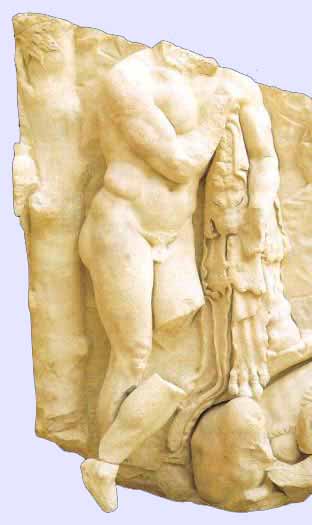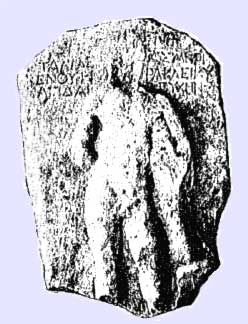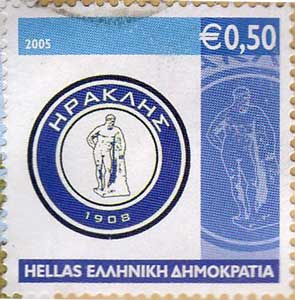.
Hellenistische Kunst : Herakles Farnese

Heracles of the Farnese type, 3rd century BC or Imperial Era Roman copy from an original by Lysippos. Bronze statuette found in Foligno, Italy.
Dimensions H. 42.5 cm (16 ½ in.) Credit line Tyszkiewicz Collection, 1870
Accession number Br 652
Location Department of Greek, Etruscan and Roman Antiquities, Sully wing, Bronzes Hall

Hercules Farnese, Napoli Metro
The Hercules Farnese is a surprising work because although Hercules, like a bodybuilder, is as we know powerful, he looks so weak. What we expect from other classical and archaic Greek sculptures to see is a proud and confident person. Hercules is represented as resting just after he obtained the 3 golden apples of the Hesperides from Atlas (assumed that he keeps these in his right hand). Hercules had to carry the entire world on his shoulders (with some help from Athena) since only Atlas could get the apples.
The Farnese Hercules, marble copy of a bronze original by Lysippus of Sicyon (Λύσιππος), a sculptor who worked for Alexander the Great, (330 BC?). Hercules is leaning against his club which is covered by his lion skin cloak. The Farnese Hercules was discovered in the Baths of Caracalla in Rome in 1540 and was soon installed within the arcade around the courtyard of the Farnese Palace. Probably a version made by the Roman Glycon of Athens (a Greek with a Roman passport?) for the Baths of Caracalla (211-217 AD) in the third century AD (See 19 th century reconstruction drawing of the great hall of the Baths of Caracalla during the Roman Empire , Aerial View ). Wolfgang von Goethe visited Rome in 1787. After seeing the Hercules Farnese he said that it is one of the most perfect works of Arts. Was the original Hercules version of Lysippus also so muscular or is this a version adapted for the Romans who I assume liked extreme bodybuilding more than the Greeks?
Hercules Farnese Studies, Variations

Probably the Hercules of the Telephos Frieze, from the Pergamon Zeus temple, is a work that is based on the resting Hercules of Lysippos. (Berlin Germany Inv. No. T.I.17 Staatliche Museen Preussischer Kulturbesitz). Right a part of a lioness and the infant Telephos .(Usually the infant Telephus is suckled by a deer but a lion was selected an animal stronger than the wolve of Remus and Romulus, a provocation for the Romans)
Many authors considered the proportions of the Hercules Farnese:




Abraham Bosse, »Représentations de diverses Figvres hvmaines, avec leurs mesures prises sur des antiqués.« Paris 1656 , or François Anne David, »Elémens du Dessin ou Proportions des plus belles figures de l'antiquité, à l'usage de ceux qui se destinant aux Beaux Arts.«, Paris 1798

Heracles Relief from the Greek city Kozani (the type of Hercules Farnese)

The 8 ½ m giant Hercules sculpture (since 1717 produced by Johann Jacob Anthoni) in the German city Kassel (Image from http://www.kassel.city-map.de/city/db/102302014200.html )
The city has a program “Wir retten unseren Herkules” (We save our Hercules). You can buy souvenirs such as small Hercules sculptures from so called Hercules shops in order to help to restore and protect the symbol of the German city of Kassel. There are souvenirs like a Hercules watch or T-shirts, posters... http://www.kassel.de/content/index.php?parent=440
(Image of the Building with Hercules on top http://home.geekster.com/germany/hofgeismar/hercules/med/mP9021080.html (click the image to load a high resolution image) from http://home.geekster.com/germany/hofgeismar/hercules/ )
A view from behind
Rubens Hercules Farnese Drawings

Hercules and Lichas, Antonio Canova, probably inspired by the Hercules Farnese. Hercules angry throws his servant Lichas into the sea. It is the last action of Hercules. He will not survive the deadly blood of Nessos.


Bernardino Genga (1620-1690) : Anatomia per uso et intelligenza del disegno ricercata non solo su gl'ossi, e muscoli del corpo humano, Rome: Domenico de Rossi, herede di Gio. Jacomo de Rossi, 1691.

A Farnese Hercules Stamp

Iraklis football (soccer) club, with the Hercules Farnese symbol used in their logo, a Greek Stamp from 2005
HENDRIK GOLTZIUS, Hercules Farnese Painting
French copy of Hercules Farnese
Statue of drunken Hercules relieving himself; Roman Tunis, Bardo Museum. Credits: Barbara McManus, 1982
Sexy bears, The Farnese Hercules and a Pissing Hercules
Lysippos Created, a film about the work of Lysippos “2300 years ago, a humble artisan from Sikyon in the Peloponese, created works of art from bronze that depicted the flowing moment of the human personality within the irripeatable passing of time.“
Hercules and Cacus, Bandinelli's sculpture (1534), Piazza della Signoria, Florence, Italy, a pendant to Michelangelo's David. Image , Another View ,
Heracles Fighting the Lion (copy of Greek original), 4th century B.C., marble, The Hermitage at St. Petersburg. (The Lion seems to be too small!)

Hendrick Goltzius 1558 - 1617, Farnese Hercules engraving published 1617
| Ancient Greece
Science, Technology , Medicine , Warfare, , Biographies , Life , Cities/Places/Maps , Arts , Literature , Philosophy ,Olympics, Mythology , History , Images Medieval Greece / Byzantine Empire Science, Technology, Arts, , Warfare , Literature, Biographies, Icons, History Modern Greece Cities, Islands, Regions, Fauna/Flora ,Biographies , History , Warfare, Science/Technology, Literature, Music , Arts , Film/Actors , Sport , Fashion --- |


